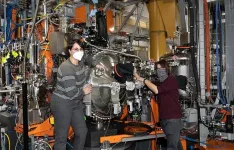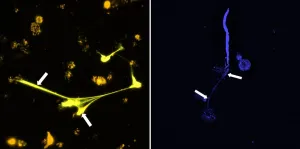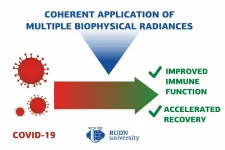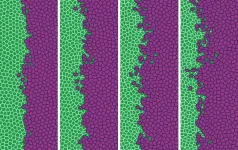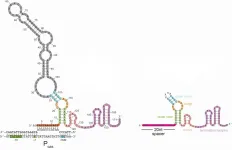Why remdesivir does not fully stop the coronavirus
Their results explain why the drug has a rather weak effect
2021-01-19
(Press-News.org) Remdesivir is the first drug against Covid-19 to be conditionally approved in Europe and the United States. The drug is designed to suppress the rapid replication of the SARS-CoV-2 virus in human cells by blocking the viral copying machine, called RNA polymerase. Researchers at the Max Planck Institute (MPI) for Biophysical Chemistry in Göttingen and the University of Würzburg have now elucidated how remdesivir interferes with the viral polymerase during copying and why it does not inhibit it completely.
"After complicated studies, we come to a simple conclusion," Max Planck Director Patrick Cramer says. "Remdesivir does interfere with the polymerase while doing its work, but only after some delay. And the drug does not fully stop the enzyme."
At the pandemic's beginning, Cramer's team at the MPI for Biophysical Chemistry had elucidated how the coronavirus duplicates its RNA genome. For the pathogen this is a colossal task as its genome comprises around 30,000 RNA building blocks, making it particularly long. To elucidate remdesivir's mechanism of action, Cramer's team collaborated with Claudia Höbartner's group. The latter produced special RNA molecules for the structural and functional studies. "Remdesivir's structure resembles that of RNA building blocks," explains Höbartner, a professor of chemistry at the University of Würzburg. The polymerase is thereby misled and integrates the substance into the growing RNA chain.
Pausing instead of blocking
After remdesivir had been incorporated into the viral genome, the researchers examined the polymerase-RNA complexes using biochemical methods and cryo-electron microscopy. They discovered that the copying process pauses precisely when three more building blocks have been added after remdesivir was incorporated into the RNA chain. "The polymerase does not allow the installation of a fourth one. This pausing is caused by only two atoms in the structure of remdesivir that get hooked at a specific site on the polymerase. However, remdesivir does not fully block RNA production. Often, the polymerase continues its work after correcting the error," explains Goran Kokic, a research associate in Cramer's lab, who together with Hauke Hillen, Dimitry Tegunov, Christian Dienemann, and Florian Seitz, had conducted the crucial experiments. They all are first authors of the publication about this work recently published in the scientific magazine Nature Communications.
Understanding how remdesivir works opens up new opportunities for scientists to tackle the virus. "Now that we know how remdesivir inhibits the corona polymerase, we can work on improving the substance and its effect. In addition, we want to search for new compounds that stop the viral copying machine," Max Planck Director Cramer says. "The vaccinations now underway are essential to bring the pandemic under control. But we also need to develop effective drugs that mitigate Covid-19 disease progression in the event of infection."
INFORMATION:
Original publication
Goran Kokic, Hauke Sven Hillen, Dimitry Tegunov, Christian Dienemann, Florian Seitz, Jana Schmitzova, Lucas Farnung, Aaron Siewert, Claudia Hoebartner, Patrick Cramer
Mechanism of SARS-CoV-2 polymerase inhibition by remdesivir
Nature Communications 12, 279 (2021)
12 January 2021
[Attachments] See images for this press release:
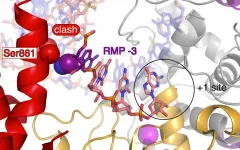
ELSE PRESS RELEASES FROM THIS DATE:
2021-01-19
UPTON, NY--Marking a major achievement in the field of spintronics, researchers at the U.S. Department of Energy's (DOE) Brookhaven National Laboratory and Yale University have demonstrated the ability to control spin dynamics in magnetic materials by altering their thickness. The study, published today in Nature Materials, could lead to smaller, more energy-efficient electronic devices.
"Instead of searching for different materials that share the right frequencies, we can now alter the thickness of a single material--iron, in this case--to find a magnetic medium that will enable the transfer of information across a device," said Brookhaven physicist and principal investigator Valentina ...
2021-01-19
Scientists have discovered a molecule that can selectively kill cells of a hard-to-treat subtype of breast cancer, which could lead to a new therapy.
The study, led by researchers at RCSI University of Medicine and Health Sciences, is published in the current edition of Science Advances.
Triple negative breast cancer is a subtype of breast cancer which is mainly treated with chemotherapy. Unfortunately, up to 70% of patients with this form of breast cancer develop resistance to treatment.
The researchers tested different molecules to see if they could selectively kill the cells of this type of breast cancer while sparing normal ...
2021-01-19
As hemp begins to reemerge as an important crop in the United States, scientists are beginning research into the diseases that might prevent the crop from flourishing. A study published in the December issue of Plant Health Progress is one of the first to study the potential disease and disorder limitations for hemp production in the southeastern United States.
Lindsey Thiessen, a plant pathologist at North Carolina State University, worked with colleagues to evaluate hemp samples from North Carolina and observed 16 different diseases. They found Fusarium flower blight most consistently followed by Helminthosporium ...
2021-01-19
A new study published in PNAS finds that aid provided by the United Nations (UN) in the aftermath of climate-related disasters is driven by humanitarian need rather than by strategic donor interests. The results underline the importance of climate-related hazards for understanding aid disbursements.
The study 'Humanitarian need drives multilateral disaster aid' provides the first estimation of UN climate-related disaster aid worldwide. Although it cannot be entirely ruled out that powerful donor states' interests shape UN aid flows, the UN seems able to fend off donor states' strategic ...
2021-01-19
Filariae, slender but sometimes up to 70 centimeters long nematodes, can set up residence in their host quite tenaciously and cause serious infectious diseases in the tropics. The tiny larvae of the worms are usually transmitted from person to person by mosquitoes, which pick up the larvae from the blood or subcutaneous tissue when they bite and deposit them in the vessels or tissues of their next victim. Researchers led by the University of Bonn (Germany) have now investigated a mechanism by which the immune system attacks the filariae. Certain immune cells, the eosinophil granulocytes, release DNA that forms a kind of web around the larvae and traps them. The researchers ...
2021-01-19
Our brains experience significant changes in blood flow and neural activity during sleep, according to Penn State researchers. Such changes may help to clean out metabolic brain waste that builds up during the day.
"We studied the sleep patterns of mice during both rapid eye movement and non-rapid eye movement sleep stages, as well as in different alertness states," said Patrick Drew, Huck Distinguished Associate Professor of Engineering Science and Mechanics, Neurosurgery and Biomedical Engineering.
Mice were chosen for the study because of their brains' remarkable similarity with human brains, said the researchers.
In both mice and humans, non-REM sleep ...
2021-01-19
A team of researchers from RUDN University and RLT suggested restoring normal levels of lymphocytes in patients with COVID-19 and other viral diseases by subjecting them to the combined influence of light, magnetic field, and ultrasound. The results of the study were published in the Journal of Photochemistry and Photobiology B: Biology.
Some COVID-19 patients are asymptomatic, while others suffer from complications. To effectively fight coronavirus with drugs and therapeutic methods, scientists and medics have to find out what causes these differences in the course of the disease. A team of scientists from RUDN University together with their colleagues from the international company Radiant Life Technologies (RLT) suggested that the reason might ...
2021-01-19
A scientific study carried out by the Universidad Carlos III de Madrid (UC3M) and the Universidad Complutense de Madrid (UCM) has produced a mathematical description of the way in which a tumor invades the epithelial cells and automatically quantifies the progression of the tumor and the remaining cell islands after its progression. The model developed by these researchers could be used to better understand the biophysical characteristics of the cells involved when developing new treatments for wound healing, organ regeneration, or cancer progression.
This research analyses the collective ...
2021-01-19
An Academic Analytics Research Center (AARC) study has found greater rates of authorship of open access (OA) research articles among scholars at more prestigious institutions with greater access to resources and job security. "The open access publishing model is growing, and open access successfully democratizes the results of research projects, but it's clear now that some scholars are more likely to be represented in the open access literature" said AARC director and lead author of the study Anthony Olejniczak, Ph.D.
The researchers analyzed characteristics of 182,320 open access authors at American research universities from 2014 through 2018. The study ...
2021-01-19
In a series of experiments with laboratory-cultured bacteria, Johns Hopkins scientists have found evidence that there is a second role for the widely used gene-cutting system CRISPR-Cas9 -- as a genetic dimmer switch for CRISPR-Cas9 genes. Its role of dialing down or dimming CRISPR-Cas9 activity may help scientists develop new ways to genetically engineer cells for research purposes.
A summary of the findings was published Jan. 8 in Cell.
First identified in the genome of gut bacteria in 1987, CRISPR-Cas9 is a naturally occurring but unusual group of genes with a potential for cutting DNA sequences in ...
LAST 30 PRESS RELEASES:
[Press-News.org] Why remdesivir does not fully stop the coronavirus
Their results explain why the drug has a rather weak effect

